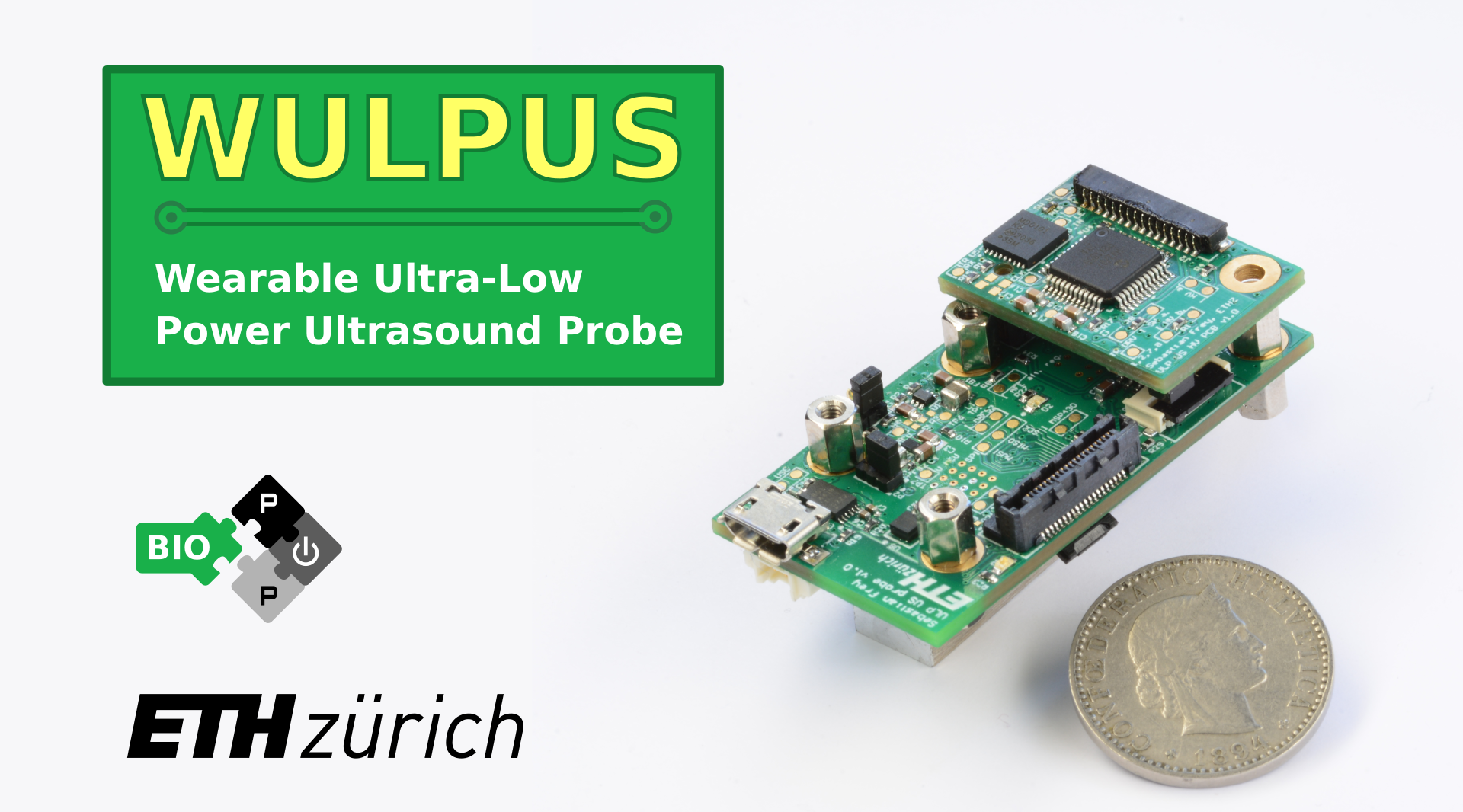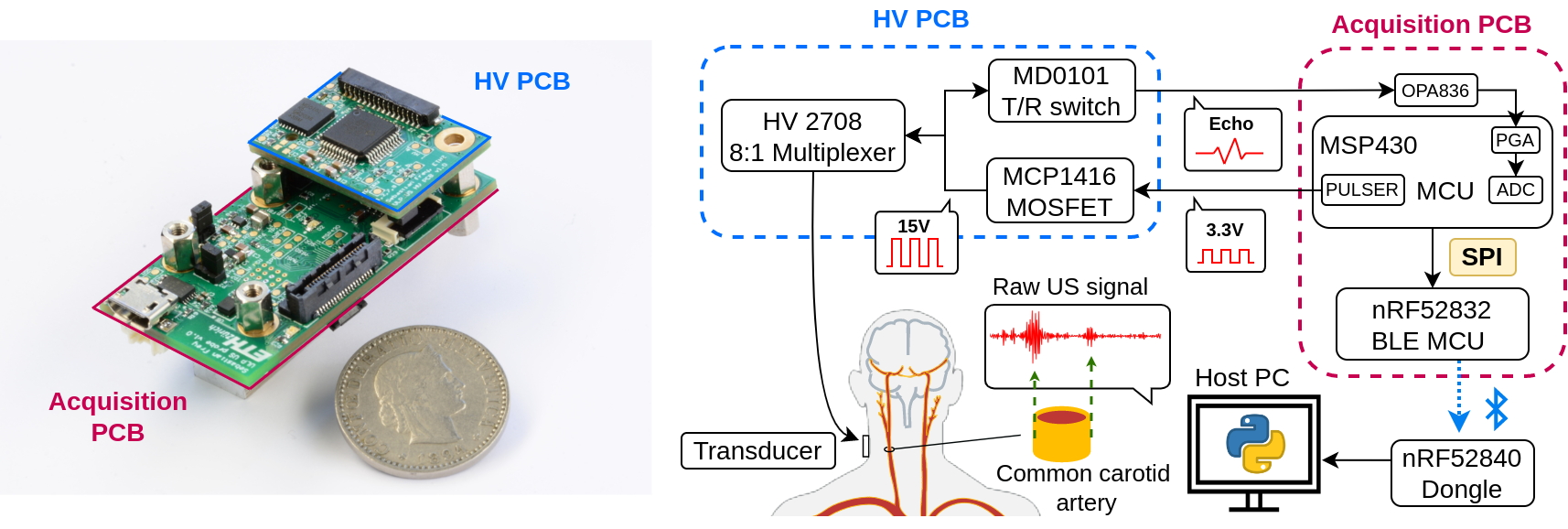This repository contains the work in progress on the WULPUS ultrasound probe.
WULPUS is a truly wearable ultra-low-power open research ultrasound platform.
The probe has the following features:
- 8 channels (time-multiplexed)
- 8 Msps Analog-to-Digital converter (12 bit resolution)
- 30.8 dB Programable-Gain Amplifier + 10 dB Operational Amplifier
- Bluetooth Low Energy (BLE) wireless link (320 kbps throughput)
- Up to 50 acquisitions per-second (APS) (400 samples per acquisition, raw data streaming mode)
- Compactness and light weight (46 x 25 mm footprint, 9 g)
- Ultra-Low Power consumption of 22 mW (raw data streaming mode, 50 APS)
WULPUS probe comprises two printed circuit boards (PCBs):
- Acquisition PCB: featuring an ultrasound MCU (MSP430FR5043) and BLE MCU (nRF52832)
- High-Voltage PCB: featuring a High-voltage multiplexer (HV MUX), a transmit/receive switch, and a MOSFET driver.
This repository has the following folders:
-
fw, containing the firmware source code, namely:- source code for the nRF52832 MCU of the WULPUS probe, located at
fw/nrf52/ble_peripheral/US_probe_nRF52_firmware - source code for the nRF52840 USB dongle, located at
fw/nrf52/peripheral/US_probe_dongle_firmware - source code for the MSP430 ultrasound MCU, located at
fw/msp430
- source code for the nRF52832 MCU of the WULPUS probe, located at
-
sw, containing the Python code for the WULPUS Graphical User Interface -
hw, containing the Altium designer source files and pdf schematics for- WULPUS Acquisition PCB (located at
hw/wulpus_acquisition_pcb) - WULPUS High-Voltage PCB (located at
hw/wulpus_hv_pcb) - WULPUS Programmer PCBs (located at
hw/wulpus_programmer_pcbs)
- WULPUS Acquisition PCB (located at
-
docs, containing the project documentation (e.g., images of the device, user manual, ...)
The comprehensive WULPUS User Manual can be found in the docs/ folder. It covers everything about WULPUS, from assembly instructions to example measurements and troubleshooting, making the platform user-friendly for everyone, regardless of technical expertise.
Please find the detailed instructions in chapter 2 of the WULPUS User Manual.
In a nutshell, to build your own instance of WULPUS, the following steps should be completed:
- PCBs manufacturing and assembly
You can find the design files (Altium source files, schematics, bills of materials) under thehwfolder. - Flashing MSP430 firmware
You can find the instructions on seting-up the toolchain, compiling the firmware and flashing the MSP430 MCU in thefw/msp430folder. - Flashing nRF52 MCU and USB dongle firmware
You can find the instructions on setting-up the toolchain, compiling the firmware, flashing the nRF52 MCU and USB dongle in thefw/nrf52folder. - Python dependencies installation on the host PC
Follow the instructions in theswfolder to install the dependencies.
Please refer to chapter 3 of the WULPUS User Manual for detailed information.
Starting a measurement with WULPUS can be accomplished in three simple steps:
- Power up the probe, either from the micro-USB connector or from the battery connector
- Connect the USB dongle to the host PC
- Activate the Python environent, launch the Jupyter notebook located in
swfolder, and follow the instructions in the notebook
If you would like to reference the project, please cite the following paper:
@inproceedings{frey2022wulpus,
title={WULPUS: a Wearable Ultra Low-Power Ultrasound probe for multi-day monitoring of carotid artery and muscle activity},
author={Frey, Sebastian and Vostrikov, Sergei and Benini, Luca and Cossettini, Andrea},
booktitle={2022 IEEE International Ultrasonics Symposium (IUS)},
pages={1--4},
year={2022},
organization={IEEE}
}
[1] Vostrikov, Sergei, et al. "Hand gesture recognition via wearable ultra-low power ultrasound and gradient-boosted tree classifiers." 2023 IEEE International Ultrasonics Symposium (IUS). IEEE, 2023.
[2] Vostrikov, Sergei, Luca Benini, and Andrea Cossettini. "Complete Cardiorespiratory Monitoring via Wearable Ultra Low Power Ultrasound." 2023 IEEE International Ultrasonics Symposium (IUS). IEEE, 2023.
[3] Frey, Sebastian, et al. "A wearable ultra-low-power semg-triggered ultrasound system for long-term muscle activity monitoring." 2023 IEEE International Ultrasonics Symposium (IUS). IEEE, 2023.
The WULPUS system was developed at the Integrated Systems Laboratory (IIS) at ETH Zurich by:
- Sergei Vostrikov (Firmware, Software, Open-Sourcing, Documentation)
- Sebastian Frey (Firmware, PCB design, Documentation)
- Luca Benini (Supervision, Conceptualization)
- Andrea Cossettini (Supervision, Project administration)
Thanks to all the people who contributed to the WULPUS platform:
- Cédric Hirschi (GUI improvements, Documentation)
- William Bruderer (Documentation)
The following files are released under Apache License 2.0 (Apache-2.0) (see sw/LICENSE):
sw/
The following files are released under Solderpad v0.51 (SHL-0.51) (see hw/LICENSE):
hw/
The following files are released under Creative Commons Attribution 4.0 International
License (CC-BY-4.0) (see docs/images/LICENSE):
docs/images/
The fw/msp430/ and fw/nrf52/ directories contain third-party sources that come with their own
licenses. See the respective folders and source files for the licenses used.
In no event and under no legal theory, whether in tort (including negligence), contract, or otherwise, unless required by applicable law (such as deliberate and grossly negligent acts) or agreed to in writing, shall any Contributor be liable to You for damages, including any direct, indirect, special, incidental, or consequential damages of any character arising as a result of this License or out of the use or inability to use the Work (including but not limited to damages for loss of goodwill, work stoppage, computer failure or malfunction, or any and all other commercial damages or losses), even if such Contributor has been advised of the possibility of such damages.

